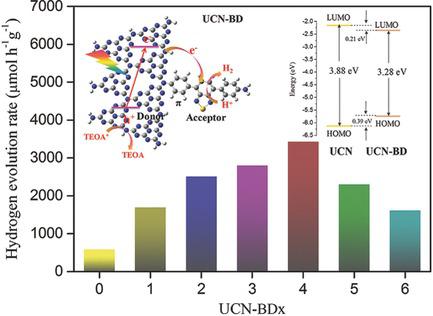Our official English website, www.x-mol.net, welcomes your
feedback! (Note: you will need to create a separate account there.)
Creating Graphitic Carbon Nitride Based Donor‐π–Acceptor‐π–Donor Structured Catalysts for Highly Photocatalytic Hydrogen Evolution
Small ( IF 13.0 ) Pub Date : 2018-02-12 , DOI: 10.1002/smll.201703599 Kui Li 1 , Wei-De Zhang 1
Small ( IF 13.0 ) Pub Date : 2018-02-12 , DOI: 10.1002/smll.201703599 Kui Li 1 , Wei-De Zhang 1
Affiliation

|
Conjugated polymers with tailored donor–acceptor units have recently attracted considerable attention in organic photovoltaic devices due to the controlled optical bandgap and retained favorable separation of charge carriers. Inspired by these advantages, an effective strategy is presented to solve the main obstructions of graphitic carbon nitride (g‐C3N4) photocatalyst for solar energy conversion, that is, inefficient visible light response and insufficient separation of photogenerated electrons and holes. Donor‐π–acceptor‐π–donor polymers are prepared by incorporating 4,4′‐(benzoc 1,2,5 thiadiazole‐4,7‐diyl) dianiline (BD) into the g‐C3N4 framework (UCN‐BD). Benefiting from the visible light band tail caused by the extended π conjugation, UCN‐BD possesses expanded visible light absorption range. More importantly, the BD monomer also acts as an electron acceptor, which endows UCN‐BD with a high degree of intramolecular charge transfer. With this unique molecular structure, the optimized UCN‐BD sample exhibits a superior performance for photocatalytic hydrogen evolution upon visible light illumination (3428 µmol h−1 g−1), which is nearly six times of that of the pristine g‐C3N4. In addition, the photocatalytic property remains stable for six cycles in 3 d. This work provides an insight into the synthesis of g‐C3N4‐based D‐π–A‐π–D systems with highly visible light response and long lifetime of intramolecular charge carriers for solar fuel production.
中文翻译:

创建基于石墨化氮化碳的供体-受体-π-供体结构化催化剂以高度光催化制氢
具有可调节的供体-受体单元的共轭聚合物由于可控制的光学带隙和保持良好的电荷载流子分离,最近在有机光伏器件中引起了相当大的关注。受这些优点的启发,提出了一种有效的策略来解决石墨化碳氮化碳(g-C 3 N 4)光催化剂用于太阳能转换的主要障碍,即可见光响应效率低以及光生电子和空穴的分离不足。给体-π-受体-给体聚合物是通过在g-C 3 N 4中掺入4,4'-(苯甲酰1,2,5噻二唑-4,7-二基)二苯胺(BD)制备的框架(UCN‐BD)。UCN‐BD受益于扩展的π共轭引起的可见光带尾,因此具有扩大的可见光吸收范围。更重要的是,BD单体还充当电子受体,这赋予UCN-BD高度的分子内电荷转移能力。具有这种独特的分子结构,经过优化的UCN-BD样品在可见光照射下(3428 µmol h -1 g -1)表现出优异的光催化制氢性能,几乎是原始g-C 3 N的六倍。4。此外,光催化性能在3天内保持6个循环稳定。这项工作提供了对g‐C 3 N 4合成的见解。基于D-π-A-π-D的系统,具有很高的可见光响应和较长的分子内电荷载体寿命,可用于生产太阳能。
更新日期:2018-02-12
中文翻译:

创建基于石墨化氮化碳的供体-受体-π-供体结构化催化剂以高度光催化制氢
具有可调节的供体-受体单元的共轭聚合物由于可控制的光学带隙和保持良好的电荷载流子分离,最近在有机光伏器件中引起了相当大的关注。受这些优点的启发,提出了一种有效的策略来解决石墨化碳氮化碳(g-C 3 N 4)光催化剂用于太阳能转换的主要障碍,即可见光响应效率低以及光生电子和空穴的分离不足。给体-π-受体-给体聚合物是通过在g-C 3 N 4中掺入4,4'-(苯甲酰1,2,5噻二唑-4,7-二基)二苯胺(BD)制备的框架(UCN‐BD)。UCN‐BD受益于扩展的π共轭引起的可见光带尾,因此具有扩大的可见光吸收范围。更重要的是,BD单体还充当电子受体,这赋予UCN-BD高度的分子内电荷转移能力。具有这种独特的分子结构,经过优化的UCN-BD样品在可见光照射下(3428 µmol h -1 g -1)表现出优异的光催化制氢性能,几乎是原始g-C 3 N的六倍。4。此外,光催化性能在3天内保持6个循环稳定。这项工作提供了对g‐C 3 N 4合成的见解。基于D-π-A-π-D的系统,具有很高的可见光响应和较长的分子内电荷载体寿命,可用于生产太阳能。











































 京公网安备 11010802027423号
京公网安备 11010802027423号